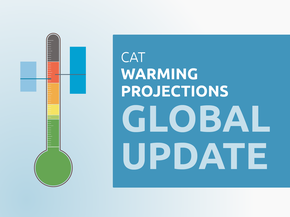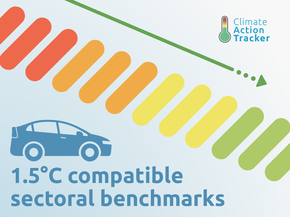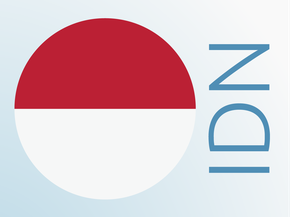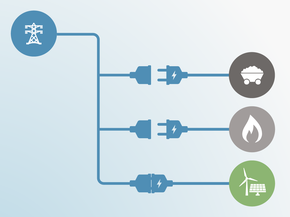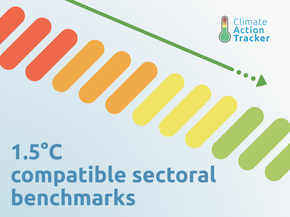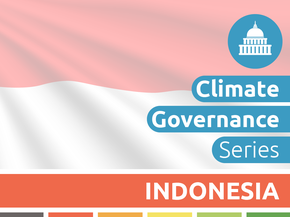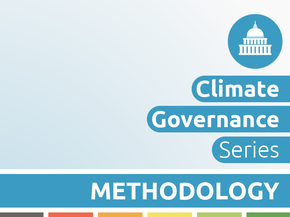Current Policy Projections
Economy-wide
In 2030, under the CAT current policies scenario, GHG emissions excl. LULUCF will increase to 1,573-1,751 MtCO2e/year, about five times the 1990 levels, and 75% to 100% higher than 2014 emissions. With these projections, Indonesia overachieves its unconditional NDC and potentially even the conditional 2030 target as well, despite strongly increasing emissions.
The emission projections come with a high uncertainty (compare section “Assumptions”).
Energy supply
The National Energy Policy (NEP), also mentioned in the NDC, has a target to increase renewable energy to 23% of total primary energy supply (TPES) by 2025, from today’s share of 6.5% (MEMR Indonesia, 2017, p. 11). However, renewables uptake has been happening at a somewhat modest rate. The total new renewable investment in 2017 was about $1 billion – while two major geothermal power projects were inked last year, solar and wind investments lagged (UNEP-BNEF, 2018). Indonesia’s biofuel blending target is among the most ambitious mandates globally (ICCT, 2016), however there are issues around the impact on deforestation (see below under transport, agriculture).
While efforts towards renewables uptake are only slowly taking shape, the Indonesian plans also foresee capacity expansion for coal and gas power plants - a development likely to bind the country to a carbon-intensive power sector for many decades. Various other sources also predict that coal will keep playing a major role in Indonesia’s energy mix in the foreseeable future, i.e. (APERC, 2016). However, coal power expansion plans are increasingly under question, as energy demand seems to be growing at a lower pace (The Jakata Post, 2018) and long-term PPAs increase risk of locking-in costly capacity payments to thermal power plants while renewables become cheaper (IEEFA, 2017).Under current policy projections the NEP targets will not be met, the assumed role of coal in our projections is even stronger than what it would be under the lock-in envisaged under the NEP. The Electricity Supply Business Plan (RUPTL) 2018–2027, published in 2018, defines a target of 56 GW of new capacity in the next decade (of which 33 GW will come online in the next five years). This slashes last year’s plan by a third due to lower than expected growth in energy demand. Still, 27 GW of coal capacity is expected to be added (of which 17 GW will be over the next five years), while particularly gas received higher cuts in targets for newly installed capacity: Planned coal capacities went down from 32 to 27 GW, gas from 25 to 15 GW, and RE from 16 to 15 GW. An installed capacity of 27 GW of coal-fired power plants will emit up to 200 MtCO2e/a (depending on capacity factor and efficiency). Unless the coal plants are decommissioned before the end of their lifetime, they will continue to emit this amount over the next 40 years.
Indonesia’s energy planning (RUPTL 2018) does not include quantitative cost estimates for different technologies, the chapter on electricity generation costs merely describes qualitative considerations such as the competitiveness of the economy.
These developments in energy policy represent an apparent mismatch in the context of energy policy with, on the one hand, renewables being pushed to play a stronger role in the energy mix, but, on the other hand, locking in the role of coal. While achieving the targets of the NEP would result in emission reductions compared to current policy projections, it is to be noted that even under those targets the roles of especially coal, but also oil and gas, would remain locked-in across the coming decades, making a deep reduction of emissions extremely difficult and very costly.
Industry
Cement, ammonia-based fertilisers and metal industries are the biggest emitting industries in Indonesia as per the Third National Communication. The Indonesian government is focussing on reducing cement industry emissions by lowering an already low clinker-to-cement ratio. Voluntary guidelines have been developed to encourage use of blended cement by use of clinker substitutes such as fly ash and using biomass and other alternative fuel and raw materials (AFR) in the cement production process. Indonesia also has various CDM projects in the cement sector In addition, there are plans for energy audits and conservation for all energy intensive industries (Government of Indonesia, 2018).
The CAT has not quantified the impact of those policies separately. The Third National Communication shows minor reductions for the year 2020. Reductions beyond 2020 are not provided.
Buildings
Growing middle-class demands for infrastructure means a continued relevance of the building sector in Indonesia. Regulation 36/2005 under Law No. 28/2002 sets energy standards for buildings (SNI) outlining the building envelop, air conditioning and lighting appliances, and an energy audit procedure (GBPN, 2013; IEA, 2016). Further, Energy Performance Certificates are mandated for building users whose energy consumption is beyond 6000 toe/year. These users are required conduct an energy audit and implement its recommendation, and report result of the implementation energy measures to the government. Indonesia also has a mandatory labelling for lighting ballasts (since 2011), MEPS and mandatory labelling for air conditioning (since 2016) and are under development for refrigeration, cooking, washing machines, dishwashers and motors (CLASP, 2018; IEA, 2016). In addition, municipal actors have been active in promoting green building concepts. In 2012, Jakarta passed a mandatory Green Building regulation. Compliance with energy conservation and efficiency regulations, however, is not well documented (GBPN, 2013).
Transport
Indonesia’s biofuel blending mandate is one of the most ambitious in the world. The National Energy Policy under Presidential Regulation No. 5/2006 initially pronounced the aim of having a 5% share of biofuels (ethanol and biodiesel) in national energy consumption by 2025. Since 2008, regulations by the Ministry of Energy and Mineral Resources (MEMR) have further adapted and specified biofuel targets to a sector level. However, there are issues around the biofuel targets relating to palm oil (see Agriculture section). According to Ministerial Regulation No. 12/2015, a 30% biofuel blending is to be achieved for transportation, industry, and electricity production by 2020 and 2025 (ICCT, 2016).
Mitigation actions on transport infrastructure and planning in Indonesia are being guided by the Transportation Decree No. 201/2013 of 2013 and include a major overhaul of the existing system with an "avoid, shift and improve" approach. The NAMA facility supported NAMA SUTRI – implemented in 7 pilot cities - is also mentioned as a key instrument to support transformation in the third national communication. Construction of electrification and double tracking the colonial era railway corridors is also touted as a high impact mitigation measure in the Third National Communication
Agriculture
The demand for biofuels will have impacts for the agricultural sector, as this demand may be met by expanding domestic palm oil industries. While oil palm plantations in Indonesia are required to be ISPO-certified (Indonesian Sustainable Palm Oil), plantations for biofuel production are specifically exempt from this. As the total area of palm oil plantations in Indonesia has risen more than tenfold in the period 1990–2015 (US Department of Agriculture, 2016), while forest cover declined by about 20% (World Bank, 2015), production of biofuels from palm oil is “predicated on a vision of biofuel expansion that would require extensive deforestation,“ according to the ICCT (ICCT, 2016). Options to prevent this could require incentivising the creation of new palm oil plantations only on degraded lands, or support biofuel production from oil palm residues (ICCT, 2016). The Third National Communication allocates highest mitigation target to developing palm plantation area on non-forested land/abandoned land/ degraded land/other use areas, but the exact approach to achieve this is neither well-explained nor easily traceable.
Forestry
Indonesia’s deforestation already contributes to a large share of global deforestation emissions. In Indonesia’s GHG inventory for 2014, forests and lands were a net source of emissions of almost 1 GtCO2e (compared to that, global emissions from LULUCF in 2016 were about 4.1 GtCO2e). Assessing a LULUCF emissions trajectory is somewhat complicated by the fact that these emissions have shown large fluctuations due, among other things, to the variability of emissions from peat fires to external factors such as the influence by El Niño.
As part of the National Action Plan for Greenhouse Gas Emission Reduction (RAN-GRK), Indonesia identified actions in the forestry sector. Those are sustainable peat land management, reducing the deforestation and land degradation rate, and developing carbon sequestration projects in forestry and agriculture (Mersmann et al., 2017). These efforts are reinforced through the REDD+ Task Force, which in the short and medium term focuses on improving governance of forests, and in the long term aims at turning Indonesia’s forests and lands into a net carbon sink (ibid). In the Third National Communication, Indonesia describes 13 “core mitigation plans” that have been pursued since 2010, each with a quantitative emission reduction target attributed to them. All targets add up to reductions of 810 MtCO2e/a. CAT does not quantify the expected impact itself.
Laws in place to regulate the sector are the moratorium from 2015 for new permits and improvement of forest and peatland governance and the National Strategy for Forest Law Enforcement in Indonesia from 2005, a programme to combat illegal logging. Indonesia is also pursuing the One Map Policy, with the objective to create a transparent monitoring system of forest areas (Mulyani & Jepson, 2016).
Separate assessments of Indonesia’s LULUCF emissions were made in the 2015 and 2016 assessments for the country. LULUCF emissions may be a huge uncertainty factor in assessing the extent to which Indonesia is in line with meeting its NDC, despite the fact that the CAT does not assess the LULUCF component of the NDC.
Further analysis
Country-related publications
Stay informed
Subscribe to our newsletter
